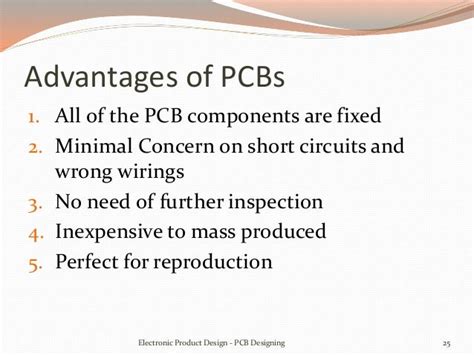Environmental Impact of PCB Manufacturing
One of the main disadvantages of PCBs is their environmental impact during the manufacturing process. The production of PCBs involves the use of hazardous chemicals and materials that can harm the environment if not properly managed.
Chemicals Used in PCB Manufacturing
| Chemical | Purpose | Environmental Concerns |
|---|---|---|
| Copper | Conductive layer for electrical connections | Mining and extraction impact, heavy metal release |
| Lead | Used in solder for component attachment | Toxic, can contaminate soil and water |
| Brominated Flame Retardants (BFRs) | Added to PCB substrate to reduce flammability | Persistent organic pollutants, bioaccumulation |
| Acid-based etchants | Removing excess copper during PCB fabrication | Acidic waste, water pollution |
The use and disposal of these chemicals can lead to environmental contamination if not handled properly. Manufacturers must follow strict regulations and guidelines to minimize the environmental impact of PCB production.
E-waste and PCB Disposal
Another environmental concern related to PCBs is the generation of electronic waste (e-waste) when devices containing PCBs reach the end of their life. Improper disposal of PCBs can lead to the release of toxic substances into the environment.
| E-waste Component | Environmental Concern |
|---|---|
| Heavy metals | Leaching into soil and groundwater, bioaccumulation |
| Plastics | Non-biodegradable, can release toxins when burned |
| Flame retardants | Persistent organic pollutants, harmful to wildlife |
To mitigate these issues, proper e-waste management and recycling practices must be implemented. Many countries have established e-waste recycling programs and regulations to ensure the safe disposal and recovery of valuable materials from PCBs.
Manufacturing Complexity and Cost
The manufacturing process for PCBs can be complex and costly, especially for high-density or multi-layer boards.
Manufacturing Steps
- PCB design and layout
- Substrate preparation
- Copper deposition and patterning
- Solder mask and silkscreen application
- Component assembly and soldering
- Testing and quality control
Each of these steps requires specialized equipment, materials, and skilled labor, contributing to the overall cost of PCB manufacturing.
Cost Factors
| Factor | Impact on Cost |
|---|---|
| Board size | Larger boards require more material and processing |
| Layer count | Additional layers increase complexity and cost |
| Material choice | High-performance materials are more expensive |
| Quantity | Higher volumes can reduce per-unit costs |
| Design complexity | Dense layouts and fine features increase cost |
Manufacturers must carefully balance these cost factors with the performance and reliability requirements of the intended application.
Limitations in PCB Design and Performance
PCBs also have inherent limitations in terms of design flexibility and performance, which can impact their suitability for certain applications.
Signal Integrity Challenges
As electronic devices become faster and more complex, maintaining signal integrity on PCBs becomes increasingly challenging. Factors such as crosstalk, electromagnetic interference (EMI), and signal reflections can degrade the quality of signals transmitted on the board.
| Signal Integrity Issue | Cause | Mitigation Strategies |
|---|---|---|
| Crosstalk | Unwanted coupling between adjacent traces | Increase trace spacing, use guard traces |
| EMI | External electromagnetic fields interfering with signals | Shielding, proper grounding, filtering |
| Signal reflections | Impedance mismatches causing signal reflections | Impedance matching, termination techniques |
Designers must carefully consider these issues and employ appropriate mitigation strategies to ensure reliable PCB performance.
Thermal Management Concerns
PCBs can also face thermal management challenges, particularly in high-power applications or densely populated boards. Insufficient heat dissipation can lead to component failure and reduced reliability.
| Thermal Management Technique | Description |
|---|---|
| Copper pours | Large copper areas to spread heat |
| Thermal vias | Vias that transfer heat to other layers or heatsinks |
| Heatsinks | External components that dissipate heat from the PCB |
| Forced air cooling | Fans or blowers that actively remove heat |
Proper thermal management is crucial to ensure the long-term reliability and performance of PCBs in demanding applications.

FAQ
-
Q: Are there alternatives to traditional PCB manufacturing that are more environmentally friendly?
A: Yes, there are several alternatives, such as using biodegradable PCB substrates, lead-free solder, and water-based cleaning agents. However, these alternatives may have limitations in terms of performance or cost compared to traditional methods. -
Q: How can I reduce the cost of PCB manufacturing for my project?
A: Some strategies to reduce PCB manufacturing costs include optimizing your board size and layer count, choosing cost-effective materials, and ordering in larger quantities. Working with an experienced PCB manufacturer and discussing your project requirements can also help identify cost-saving opportunities. -
Q: What can I do to ensure signal integrity in my PCB design?
A: To maintain signal integrity, you can follow best practices such as minimizing trace lengths, using appropriate trace widths and spacing, implementing proper grounding and shielding techniques, and using simulation tools to analyze and optimize your design. -
Q: How can I improve the thermal management of my PCB?
A: Improving thermal management can be achieved through techniques such as using larger copper pours, adding thermal vias, incorporating heatsinks, and using forced air cooling. It’s also essential to consider the placement and power dissipation of components during the design phase. -
Q: Are there any regulations or standards I need to follow when disposing of PCBs?
A: Yes, there are various regulations and standards related to e-waste management and PCB disposal, which can vary by country or region. It’s important to familiarize yourself with the applicable regulations and work with certified e-waste recyclers to ensure proper disposal and minimize environmental impact.
In conclusion, while PCBs have revolutionized the electronics industry, they also have several disadvantages that should be considered, including environmental impact, manufacturing complexity and cost, and limitations in design and performance. By understanding these challenges and employing appropriate mitigation strategies, designers and manufacturers can work to minimize the negative aspects of PCBs while leveraging their benefits in a wide range of applications.

No responses yet